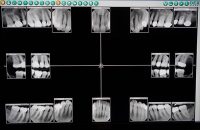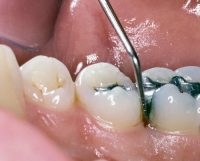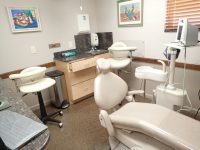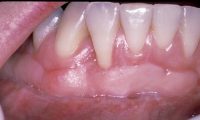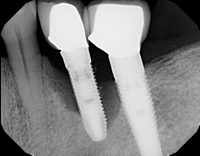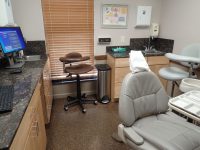Initial Periodontal Therapy
Scaling & Root Planing
When periodontal pockets have developed, the first phase of treatment involves scaling and root planing. This initial periodontal therapy is needed to disinfect the pockets, control inflammation, and stop advancing bone loss. It is a non-surgical procedure, which in our office, is always performed by Dr. Pechter, rather than delegating to one of our skilled hygienists. Dr. Pechter carefully cleans the root surfaces beneath the gum line, removing plaque, toxins, and retentive calculus from the roots. A local anesthetic (“Novocaine”) is administered so that your teeth and gums will not be sensitive during treatment. Sometimes, antibiotic medication is applied directly into deeper pockets to aid healing.
In conjunction with good home plaque control by the patient, treatment results in reduced pocket depths and reduced gingival bleeding. Because a coating of bacteria and calculus has been removed from the roots, teeth may become temporarily more sensitive to cold and chewing following treatment. This usually returns to normal after a couple of weeks. Realizing this, we typically treat one side of the mouth (upper and lower) at one visit, and the other side two to three weeks later. This allows you to chew comfortably on the untreated side, while the treated side is healing.
Gums tend to shrink and tighten around the teeth as they become less inflamed, which sometimes will result in slight recession. But this is certainly preferable to the uncontrolled continuing bone loss and recession that will occur if therapy is not performed.

Periodontal Surgery
Flap Root Planing:
When periodontal pockets are too deep to access non-surgically, or if gingival inflammation is more severe, it is often necessary to expose the roots by gently peeling back the overlying gum tissue. This procedure is known as a flap. Local anesthetic is used, the same as it is for non-surgical root planing. A flap allows the doctor to actually see the roots for scaling and root planing, rather than proceeding only by feel. If a flap is not reflected for deeper pockets, inevitably, unseen retentive calculus will be left remaining on the roots. This will continue to perpetuate the periodontal lesion, and adversely affect healing.
In cases where more severe gingival inflammation is present, flap root planing is actually much kinder to the soft tissues than non-surgical treatment. Attempting to root plane within very inflamed gums may tear the delicate tissues and leave them irregular and raw. By first reflecting a flap to separate the gums from the teeth, these frail tissues are protected and preserved, while allowing the doctor full access to the roots of the teeth for treatment. After the roots have been thoroughly cleaned, the flap is stitched back into position around the teeth. Sometimes, a periodontal dressing is placed to reduce initial post-operative sensitivity. This is a putty-like material that is molded around the teeth and gums. Stitches and dressing are removed after one week. It takes six to eight weeks for complete reattachment of the gum to the roots.
Gingival shrinkage and pocket reduction are more profound following flap root planing than following a non-flap approach. Since pocket depths and bone loss are more advanced in these cases at the start, there is also more room for improvement following therapy.
Bone Grafting:
In cases of more advanced bone loss around teeth which have not become loose, or teeth that may be essential supports of pre-existing permanent bridges, bone grafting may be attempted to regenerate lost periodontal attachment. This treatment is similar to flap root planing, except before stitching the gum tissue back into place, bone graft material is used to fill bone defects around the roots. The graft material may consist of bone taken from elsewhere in the jaw, bone from a tissue bank, or a bone substitute. Dr. Pechter may also draw some blood from your arm to prepare a concentration of blood platelets, known as platelet rich plasma (PRP), to mix with the graft. This concentrate of your own blood platelets contains healing and growth factors for improved results.
Before placing the graft, special medications are applied to the roots for more complete cleansing, and to stimulate reattachment of the grafted bone to the root. A special membrane is sometimes positioned over the entire graft to contain the graft particles, and prevent gum tissue from invading the space. This is known as guided tissue regeneration or GTR.
It is important to realize that periodontal bone grafting is neither 100% predictable nor 100% successful. Although bone can predictably be used to fill an extraction socket in preparation for a dental implant, getting bone to reattach to a previously diseased root surface is far less certain. Sometimes the deeper portion of the graft successfully attaches to the root, while leaving a residual shallower pocket remaining. Although this may be an improvement, it may break down over time. For these reasons, Dr. Pechter only recommends periodontal bone grafting for teeth that are essential to the support of pre-existing permanent bridges, or for non-mobile teeth with deep bone loss in patients who are highly motivated to avoid or postpone tooth loss.
Periodontal Maintenance
Following completion of active periodontal therapy, continued maintenance care is essential to prevent disease recurrence. Even though your teeth and gums may be healthy after treatment, opportunistic bacteria remain in your mouth, which can re-accumulate in periodontal pockets under the gum line. These areas are thoroughly debrided by our hygienists when you are seen here for recall and maintenance care. If needed, your gums can be irrigated with an anesthetic solution to reduce sensitivity during these deep cleanings.
Dr. Pechter reevaluates your periodontal status at each recall visit, keeping up to date records with computerized periodontal charting. At Dr. Pechter’s direction, localized antibiotic can be placed into deeper pockets at maintenance visits to further retard bacterial regrowth. This detailed attention by Dr. Pechter at every visit is an added value of periodontal maintenance care at this office.
It is most beneficial to alternate maintenance appointments between our office and your general dentist. Although we keep meticulous periodontal records, your general dentist is better equipped to monitor for caries (cavities) and restorative needs.
Customer Feedback
You will find no better medical team: all are capable and communicative, led by the highly skilled Dr. Pechter. All my questions were answered, everyone did their best to make me comfortable, including some lengthy procedures I needed. You can get a nice discount on certain services if you pay by check, always a nice option. This office gets my highest recommendation for consistently expert results.
A hearty and sincere thank you and well done! My teeth feel great due to your skills, diligence, thoroughness, and professionalism! Thank you very much.
Thank you for all your care and exceptional treatment over the past year. My dental implants have given me a beautiful smile and the confidence to eat whatever I desire.
I’ve been a patient of Dr. Stuart Pechter’s since 2001 and have been through numerous procedures in his well-run office. Every procedure has been pain-free and complication-free. Dr. Pechter truly has golden hands and superior expertise in the field of periodontics.
United States Marine Corps takes pleasure in recognizing Dr. Stuart Pechter for exemplary support and superior commitment. Your selfless dedication, level of commitment and assistance toward your Marine Recruiters is a testament to a heightened standard of excellence and is in keeping with the finest traditions of American patriotism and loyalty. Semper Fidelis!
Thank you for saving my teeth. I’m so glad I was referred to you for a second opinion. I wish I had come to you sooner. I never thought my teeth would ever feel this good again. Now I can really enjoy my wife’s cooking.

Stuart B. Pechter, D.M.D.
1280 Lantana Rd
Lantana, FL 33462
Phone: (561) 582-5207
Email: info@pechterperio.com










